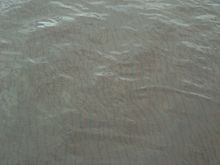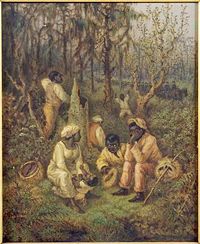- Great Dismal Swamp
-
Coordinates: 36°38′27″N 76°27′06″W / 36.640876°N 76.451797°W
The Great Dismal Swamp is a marshy area on the Coastal Plain Region of southeastern Virginia and northeastern North Carolina between Norfolk, Virginia, and Elizabeth City, North Carolina in the United States. It is located in parts of southern Chesapeake and Suffolk in Virginia, as well as northern Gates, Pasquotank, and Camden Counties in North Carolina. It is a southern swamp, one of many along the Atlantic Ocean's coast including the Everglades and the Big Cypress Swamp in Florida, the Okefenokee Swamp in Georgia, the Congaree Swamp and Four Holes swamps of South Carolina, and some of the Carolina bays in the Carolinas and Georgia. Along the eastern edge runs the Dismal Swamp Canal, completed in 1805.
Essential to the swamp ecosystem are its water resources, native vegetative communities, and varied wildlife species. The Great Dismal Swamp's ecological significance and its wealth of history and lore make it a unique wilderness. It is one of the last large and wild areas remaining in the Eastern United States.
After centuries of logging and other human activities which were devastating the swamp's ecosystems, the Great Dismal Swamp National Wildlife Refuge was created in 1973 when the Union Camp Corporation of Franklin, Virginia donated 49,100 acres (200 km²) of land; the refuge was officially established through The Dismal Swamp Act of 1974.
The refuge consists of over 111,000 acres (500 km²) of forested wetlands. Lake Drummond, a 3,100 acre (13 km²) natural lake, is located in the heart of the swamp. Outside the boundaries of the National Refuge, the state of North Carolina has preserved and protected additional portions of the swamp, as the Great Dismal Swamp State Natural Area.
Contents
History
Scientists believe the Great Dismal Swamp was created when the continental shelf made its last big shift. The swamp consists mainly of peat and water. The origin of Lake Drummond, one of only two natural lakes in Virginia, is not entirely clear. Native American legends tell of a giant "firebird" that made a nest of fire in the swamp; the nest later filled with rain.[1]
There is archaeological evidence that 13,000 years ago, people lived in the swamp. In 1650, there were Native Americans in the Great Dismal Swamp, but white immigrants showed little interest. In 1665, William Drummond, the first governor of North Carolina, discovered the lake, which was subsequently named for him.[2] In 1728, William Byrd II, while leading a land survey to establish a boundary between the Virginia and North Carolina colonies, made many observations of the swamp, none of them favorable. He is credited with naming it the Dismal Swamp.[2] In 1763, George Washington visited the area, and he and others founded the Dismal Swamp Company, a venture to drain the swamp and clear it for settlement.[3] Later the company turned to the more profitable goal of timber harvesting.[4]
We also know that several African American maroon societies lived in the Great Dismal Swamp during early American history. These marooners consisted of runaway black slaves who were seeking safety and liberty.
The Dismal Swamp Canal was authorized by Virginia in 1787 and by North Carolina in 1790. Construction began in 1793 and was completed in 1805. The canal, and a railroad constructed through part of the swamp in 1830, permitted timber to be harvested. The canal deteriorated after the Albemarle and Chesapeake Canal was completed in 1858, but in 1929 the U. S. Government bought the Dismal Swamp Canal and began to improve it. It is now the oldest operating artificial waterway in the country. Like the Albemarle and Chesapeake Canal, it is part of the Atlantic Intracoastal Waterway.[2]
At one point the Great Dismal Swamp was home to a settlement of escaped slaves.[5] Its role in the history of slavery in the United States is reflected in Harriet Beecher Stowe's second novel, Dred: A Tale of the Great Dismal Swamp. A permanent exhibit of fugitive slave life will be established in the Fall of 2011 documenting recent archeological finds.[6]
Preservation
 Photograph of the reddish colored sand of the shallow water on a calm day of Lake Drummond, Great Dismal Swamp National Wildlife Refuge, Virginia
Photograph of the reddish colored sand of the shallow water on a calm day of Lake Drummond, Great Dismal Swamp National Wildlife Refuge, Virginia
In the mid 20th century, conservation groups from all over America began demanding that something be done to preserve what was left of the Great Dismal Swamp. In 1973, the Union Camp Corporation, a paper company based in Franklin, Virginia, which had had large land holdings in the area since the beginning of the 20th century, donated just over 49,000 acres (198 km²) of its land to The Nature Conservancy, which transferred the property the following year to the U.S. Fish and Wildlife Service.[7]
The Great Dismal Swamp National Wildlife Refuge was officially established by the U.S. Congress through The Dismal Swamp Act of 1974. The refuge consists of almost 107,000 acres (433 km²) of forested wetlands.
The refuge's resource management programs aim to restore and maintain the natural biological diversity that once existed in the swamp, including its water resources, native vegetation communities, and wildlife species. Water control structures in the ditches help conserve and manage water. Forest management activities which simulate the ecological effects of wildfires are used to restore and maintain plant diversity.[7] Wildlife is managed by insuring the presence of required habitats, with hunting used to balance some wildlife populations with available food supplies.
Today
The Great Dismal Swamp National Wildlife Refuge lies wholly within the Middle Atlantic coastal forests ecoregion.[8] It harbors a wide range of plant and animal species. Bald cypress, tupelo, maple, Atlantic white cypress, and pine are among the tree species found on the refuge and support the wildlife within. The swamp is home to many mammal species, including black bear, bobcat, otter, and weasel, along with over 70 species of reptiles and amphibians. More than 200 bird species can be seen at the swamp throughout the year, while 96 of those are known to nest on the refuge.[7]
Lake Drummond is the middle of activity in the swamp today with many fishermen, sightseers, and boaters. Camping is not allowed on the refuge but is allowed on the Lake Drummond Reservation (Corps of Engineers' site) which is located at the Feeder Ditch spillway. Access to this site is by boat only.
References
- ^ Traylor, Waverley (2010). The Great Dismal Swamp in Myth and Legend, p. 214. Dorrance Publishing.
- ^ a b c Harper, Raymond L. (2008). A History of Chesapeake, Virginia, pp. 124-28. The History Press.
- ^ Grizzard, Frank E., Jr. (2002). George Washington: A Biographical Companion, pp. 86-87. ABC-CLIO.
- ^ Traylor (2010), pp. 165-66.
- ^ Kate Taylor, The Thorny Path to a National Black Museum, The New York Times, January 22, 2011, Accessed January 23, 2011.
- ^ http://www.seattlepi.com/news/article/Southern-swamp-holds-clues-about-runaway-slaves-1451698.php
- ^ a b c Yarsinske, Amy Waters (2007). The Elizabeth River, pp. 328-29. The History Press.
- ^ Olson, D. M, E. Dinerstein, et al (2001). "Terrestrial Ecoregions of the World: A New Map of Life on Earth". BioScience 51 (11): 933–938. doi:10.1641/0006-3568(2001)051[0933:TEOTWA]2.0.CO;2. http://gis.wwfus.org/wildfinder/.
External links
- Great Dismal Swamp National Wildlife Refuge Official Site
- GORP's guide to The Great Dismal Swamp
- Dismal Swamp Canal Welcome Center
- Defenders of Wildlife Organization - Great Dismal Swamp page
- Bonny Blue Dismal Swamp Canal Trip
- Elizabeth City Area Convention & Visitors Bureau
- Historical and Photo Documentary of the Great Dismal Swamp
Categories:- Protected areas of Camden County, North Carolina
- Protected areas of Gates County, North Carolina
- Protected areas of Pasquotank County, North Carolina
- Geography of Suffolk, Virginia
- Swamps of North Carolina
- Swamps of Virginia
- Underground Railroad locations
- National Natural Landmarks in Virginia
- National Natural Landmarks in North Carolina
- Geography of Chesapeake, Virginia
Wikimedia Foundation. 2010.



